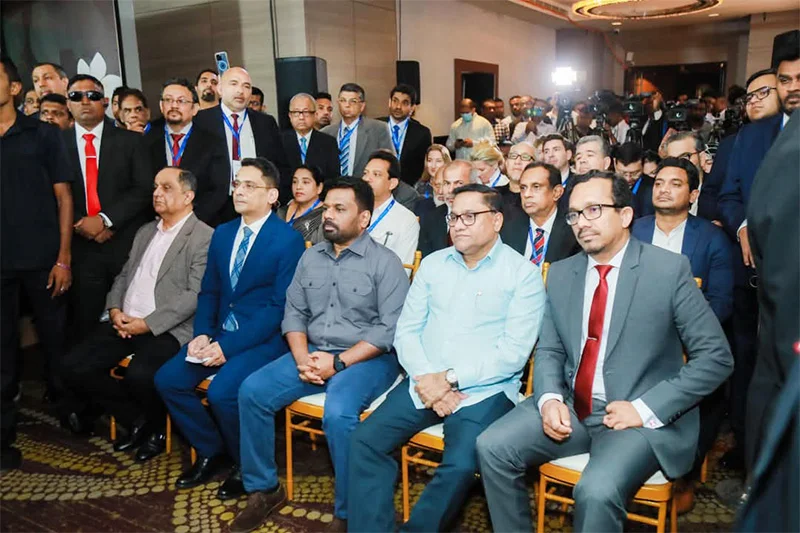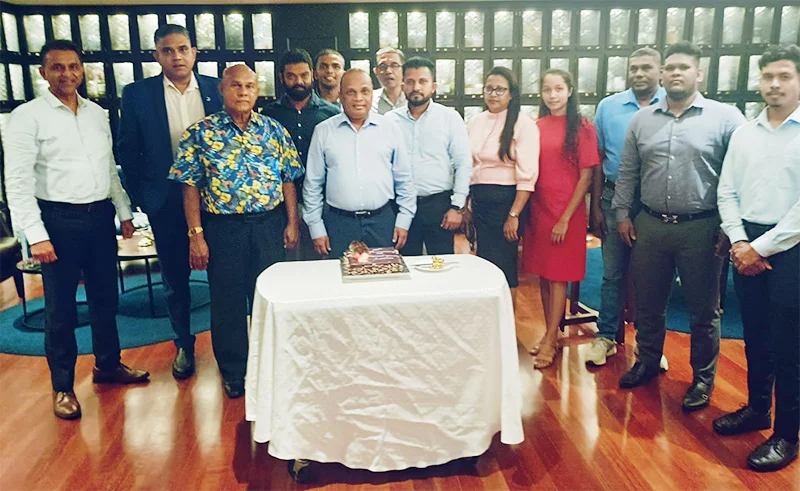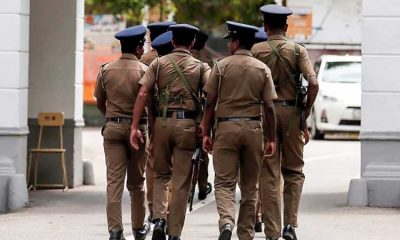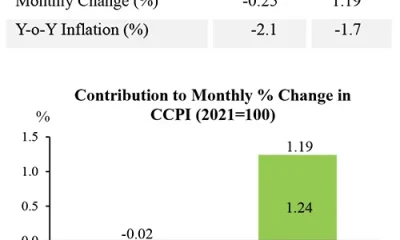Business
The X-Press Pearl disaster and the imperative for regional maritime cooperation

Righting the Ship:
By Githmi Rabel
On 20 May 2021, Sri Lanka’s worst-ever marine disaster occurred when a fire erupted on the Singapore-registered MV X-Press Pearl container ship just 18 km Northwest of Colombo. While the long-term cost is yet to be determined, the negative impact on industries such as fisheries and tourism, and people who rely on the coastal resources of Sri Lanka is already apparent. This article examines the key consequences of this disaster on Sri Lanka’s coastal economy and highlights the need to enhance regional maritime cooperation to prevent the recurrence of such disasters.
Impact on Fisheries and
Fishing Activities
The fisheries industry is an important sub-sector of the Sri Lankan economy; it accounts for 1.3% of GDP at current prices, exhibited a growth rate of 9.9% and accounted for 1.5% of export earnings in 2019. It is also a source of many direct and indirect employment opportunities from fishing to processing, distributing and trade and boat-building and maintenance. Approximately 583,000 individuals are employed in this industry and there is a supporting workforce of 2.7 million. It is also crucial to note that fish contributes more than 60% of all animal protein consumed in Sri Lanka and is the main source of protein for low-income groups.
However, following the fire and the consequent spill of nitric acid and plastic pellets into the sea and nearby coast, fishing was temporarily banned along an 80 km stretch of the coast. The effect on the local community has been stark, with some estimates claiming that around 16,000 fishers were affected. The X-Press Pearl fire, which disrupted the fisheries supply chain, from fishers to processors to wholesale and retail traders, made the fishing community more susceptible to the structural economic and social inequality they already faced. The coastal fishing community, one of the three sub-sectors of the fisheries sector of Sri Lanka, is the most vulnerable as they are daily income earners. The loss of even a single day’s income severely affects the ability of a fisher’s family to meet their basic needs. Furthermore, for most involved in this industry, there are no alternative means of income.
Of the LKR 720 million compensation received by the government, LKR 420 million has been set aside for the fishing community affected by the fire and fixed prices have been set for fishing gear and equipment in consultation with relevant businessmen. But it is important to understand the context in which this marine disaster occurred: the fisheries industry was already severely impacted by the pandemic. Islandwide curfews, cross-border mobility restrictions and trade regulations led to various constraints on access to necessary equipment and markets.
Ecological Impact and Tourism
Sri Lanka’s coastal tourism is heavily dependent on its rich marine biodiversity. The plastic waste and potential oil spills from the ship threaten not only the beaches and seas which are home to sensitive ecosystems such as lagoons and coral reefs but also its marine life.
The Marine Environment Protection Authority (MEPA), the main government body responsible for marine pollution, has stated that the plastic waste from the ship has probably caused the “worst beach pollution in our history,” and will lead to years of ecological damage. For example, the marine pollution caused by the fire is responsible for the death of 200 marine animals —including 176 sea turtles, 20 dolphins and four whales— as of now. Plastic pellets, which are easily carried by the tide, attract toxins from the water and can cause death if ingested by marine life, have washed ashore from Puttalam to Matara. Despite various efforts such as beach cleanups, the attempt to restore the coast is ongoing.
The coast has lost much of its former beauty and attraction, and out of 15 tourist zones, eight have been affected by the fire. Furthermore, the damage caused to fish breeding areas will result in lesser yields of crabs and jumbo prawns, which are especially consumed by foreign tourists. The fear of contamination and reduced supply of these items will have an immediate financial impact on the coastal economy. There is also the fear that toxic chemicals will damage the coral reef which takes years to regenerate. This depletion and ruin of coastal resources will have a spillover effect on both the fishing community and tourism leading to a mid-to-long-term economic impact.
This is not the first ship fire or oil spill that has occurred in Sri Lankan waters, with the MT New Diamond ship fire in 2020 being one of the most significant. Sri Lanka’s position in the middle of many sea and trade routes in the Indian Ocean, where around 200 to 300 ships —mainly oil tankers from the Persian Gulf to East Asia—pass daily, makes the country especially vulnerable to marine accidents.
Moving Forward
The X-Press Pearl fire was controlled only after Sri Lanka received emergency support from India, and this clearly highlights the inadequacies of current institutions to handle a crisis of this scale. While Sri Lanka does have a domestic structure in place to prevent and manage marine pollution, it is crucial that the country works closely with others in the region to achieve the same. Currently, the MEPA has the authority to implement the National Oil Spill Contingency Plan (NOSCOP) which allows the mobilisation of support from the navy, coastguard and the Sri Lanka Ports Authority. However, the emergency response system is too reliant on reactive responses as opposed to more proactive approaches, which aim to not minimise the damage caused by marine pollution but to prevent it from occurring. This requires continuous monitoring of waters and heightened scrutiny, especially given that Sri Lanka is on a trajectory to become a maritime hub and expand its port capacity.
Sri Lanka can achieve this only through regional cooperation —with countries such as India, Pakistan and Bangladesh— that is based on the facilitation of knowledge, resource sharing, constant communication channels and the formulation of standardised security measures for responders. However, this must occur through a formal, binding mechanism for otherwise, any assistance provided will be purely voluntary and context dependent. For example, requests made to offload the cargo at the Hazira port in India were denied which ultimately led to the X-Press Pearl fire on Sri Lankan waters. Given that the increase in maritime traffic has not led to a proportional increase in response capacities in countries such as Sri Lanka, official regional cooperation is key in preventing marine accidents and protecting shared waters.
Link to Original Talking Economics Blog:
Righting the Ship: The X-Press Pearl Disaster and the Imperative for Regional Maritime Cooperation
Githmi Rabel is a project intern at the Institute of Policy Studies of Sri Lanka (IPS). She is an undergraduate at New York University – Abu Dhabi, majoring in Economics with a minor in Social Research and Public Policy. (Talk with Githmi – githmi@ips.lk)
Business
‘Local gem and jewellery industry at a critical juncture; its potential going untapped’

By Ifham Nizam
Sri Lanka’s gem and jewellery industry, once a jewel of the nation’s economy, is now at a critical juncture. Against this backdrop, Deputy Minister of Industry and Entrepreneurship Development Chaturanga Abeysinghe calls for urgent reforms and collective efforts to restore the industry’s global standing and unlock its untapped potential.
Highlighting the challenges, Abeysinghe remarked, “Sri Lanka has lost its gemstones in two ways – as citizens and as a country. The famed Blue Sapphire, valued at a minimum of Rs. 150,000 per carat, and other high-value gems like rubies are treasures that should place our nation on the global map. Yet, we have failed to leverage this heritage.”
The deputy minister shed light on key issues plaguing the industry:
The imposition of VAT on imported uncut gems has severely impacted local polishing and value-addition industries. “Earlier, there was a flat charge of USD 200 per consignment, but the new VAT regime has crippled gem-related businesses. In the past year, exports have dropped by 30%, he explained.
“The lack of standardization in gem pricing remains a unique challenge. The buyer determines the price of a gem, making regulation incredibly difficult, said Abeysinghe.
Abeysinghe added: “Illegal Chinese traders and issues with mining licenses further exacerbate the industry’s struggles.
“Sri Lanka must aim to become a USD 2 billion industry. To achieve this, we need to transform into a hub for gem and jewellery operations.
“The industry’s recovery depends on a coordinated effort from all stakeholders.
“We need to create specialized zones for gem and jewellery operations to attract international investors and establish Sri Lanka as a global hub.
“Industry associations and unions have come together to save this sector. This collaboration offers a unique advantage to the government in addressing immediate and long-term challenges.
“The new machinery prototype developed by the University of Sri Jayewardenepura’s engineering faculty in collaboration with the Asian Development Bank (ADB) is laudable.
“This innovative tool has the potential to modernize the sector. However, commercialization requires an additional USD 2,000, and we must act swiftly to make this a reality.
“Achieving a USD 15 billion reserve by 2028 hinges on industries like ours. Removing VAT on uncut gems is not just a demand but a necessity for the survival and growth of the sector.
“With its rich heritage and immense potential, Sri Lanka’s gem and jewellery industry stands at the threshold of a revival. However, this journey requires urgent policy reforms, investments, and collective determination to reclaim its rightful place on the world stage.”
Business
Automobiie Association ties-up with ndb Affinity Credit Card

The Automobile Association of Ceylon (AAC) celebrated its 120th anniversary recently.
The members of the Executive Committee, several other well-wishers and government and other officials participated.
At the ceremony the National Development Bank launched its Affinity Credit Card to members of AAC.
Business
Capacity-building in hotel sector, a crying need – tourism expert

By Hiran H.Senewiratne
Sri Lanka has an immense growth potential in its travel and tourism industry, yet this rich potential has not been realized. Therefore, capacity building in the hotel sector is the need of the hour to attract more tourists into the country in the future, a top travel and tourism sector expert Chandana Amaradasa said.
“At present Sri Lanka has approximately 40,000 rooms, which need to be doubled at least within the next three to five years. Apart from that the best solution would be to upgrade existing hotels which are operating to five star level, said Amaradasa who works as a Managing Director at Island Leisure Lanka, an award winning hospitality and destination management company which celebrated the 15th anniversary of its founding at Colombo Club at Hotel Taj Samudra recently.
” The Sri Lankan tourism sector is now bullish with the arrival of two million tourists in 2024, while this year we could expect 2.5 million to 3 million tourist arrivals with an expected revenue of US $ 3.5 billion to 4 billion. Therefore, capacity building in the hotel sector is now an important factor to cater to the ever increasing tourist arrivals into the country, he said.
Amaradasa, former Senior Manager of Taj Hotels and former vice president, Ceylon Hotels Graduates’ Association also said that the imposition of VAT liability from zero for the inbound tourism sector is one of the disadvantages for the industry.
Amaradasa added: “Abandoned old colonial buildings, circuit bungalows and other important buildings belonging to the government should be handed over to the private sector to develop them into hotels as a short term solution for this issue.
“Tax impositions for inbound tour operators who are doing yeoman service to bring tourists into the country would definitely affect the growth of the sector. Therefore, the government and relevant authorities should immediately address that issue.”
Amaradasa who is also an Executive Committee Member PATA also said that, high quality PR campaigns are needed globally to attract high quality tourists into the country, while minimizing brain drain in the sector. “The industry is now suffering due to the exodus of high quality travel and tourism sector employees, which is an important factor to consider and address at this juncture, he said.
“Sri Lanka possesses two of the oldest golf links in the world, and could be promoted as a golf hub in the region, Amaradasa added.
-

 Features7 days ago
Features7 days agoAKD faces challenging year ahead
-

 Editorial7 days ago
Editorial7 days agoA kiri-kekiri issue
-

 Sports7 days ago
Sports7 days agoSt. Sebastian’s dominate at Bambalapitiya
-

 Features6 days ago
Features6 days agoThey, too, had a ball …Down Under
-

 News4 days ago
News4 days agoReshuffle of senior cops on the cards
-

 Business6 days ago
Business6 days agoCCPI-based headline inflation continued to remain in negative territory in December 2024
-

 Editorial6 days ago
Editorial6 days agoMessages and subtexts
-

 Editorial5 days ago
Editorial5 days agoBribe-gate and other unsolved plots













